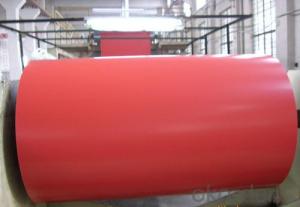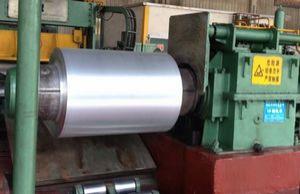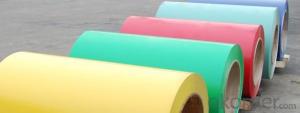York Aluminum Coil - Larger Image Color Coated Aluminum Sheet Coil for Roofing and Cladding System
- Loading Port:
- China main port
- Payment Terms:
- TT OR LC
- Min Order Qty:
- 10 m.t
- Supply Capability:
- 1000 m.t/month
OKorder Service Pledge
OKorder Financial Service
You Might Also Like
Specification
The Specification of Coated Aluminium Coil:
Application:The aluminium coil can be used to ACP,wall cladding, facades, roofs and canopies, ceilings, signboards, blind window, display platforms, electrical panels , etc
| Alloy | 1050 1060 1100 3003 3004 3005 5005 8011 etc |
| Temper | H12,H14,H16,H18,H24,H26 |
| Thickness | 0.02mm - 1.2mm |
| Width | Standard width: 1240mm |
| Special width: 1300mm,1520mm,1570mm,1595mm | |
| Diameter | Standard dia:1200mm |
| Interior dia:150mm,405mm,505mm | |
| Weight | 2.5 T/coils, 3.0 T/coil |
| Coating | PE, PVDF,ACRYLIC |
| Surface | Embossed, mill finish, coated |
| Color | As to code RAL |
| Gloss | 10-90% (EN ISO-2813:1994) |
| Coating Thickness | PE:more than 18 micron |
| PVDF: more than 25 micron | |
Coating Hardness (pencil resistance) | More than 2h |
| Coating Adhesion | 5J(en iso-2409:1994) |
| Impact Resistance | No peeling or cracking(50 kg/cm,ASTMD-2794:1993) |
PVDF Coated:
Coated Aluminum Coil features with super durability and weather resistance,and better properties to anti-acid,anti-alkali,keeping more than 15 years without fading in using as external wall cladding.
The Main Features of Aluminium Coated Coil:
1.High temperature resistant
2.Weathering resistance
3.Scrubbing resistant
4.Sound insulation
The Images of Aluminium Coated Coil:

FAQ:
Q: Can you provide free samples?
A: Yes, free samples will be sent to you on freight at destination.
Q: Can I get your latest catalogue?
A: Yes, it will be sent to you in no time.
Q: What is the MOQ?
A: 5 tons
Q: What are your payment terms?
A: We accept L/C,T/T, West Union,etc.
- Q: Can aluminum coils be used in the production of household appliances?
- Yes, aluminum coils can be used in the production of household appliances. Aluminum is a lightweight and durable material that has excellent thermal conductivity, making it ideal for applications in appliances such as refrigerators, air conditioners, and heat pumps. Aluminum coils are commonly used in the condenser and evaporator coils of these appliances, where they help transfer heat efficiently. Additionally, aluminum coils are resistant to corrosion, which is important for ensuring the longevity and performance of household appliances. Overall, aluminum coils are a popular choice in the production of household appliances due to their properties and benefits.
- Q: Are aluminum coils suitable for chemical processing applications?
- Indeed, aluminum coils prove to be fitting for chemical processing applications. Renowned for its outstanding resistance to corrosion, aluminum emerges as the perfect material for deployment in environments that harbor chemicals. Its ability to withstand numerous acids, alkalis, and solvents guarantees the longevity and sturdiness of the coils. Moreover, aluminum coils boast remarkable heat conductivity, enabling efficient heat transfer throughout the chemical processing procedure. Their lightweight composition further facilitates hassle-free handling and installation. Collectively, aluminum coils emerge as a dependable option for chemical processing applications owing to their corrosion resistance, heat conductivity, and durability.
- Q: What is the minimum thickness available for aluminum coils?
- The minimum thickness available for aluminum coils typically ranges from 0.01mm to 0.2mm, depending on the specific requirements and manufacturing capabilities.
- Q: Are aluminum coils suitable for outdoor signage?
- Indeed, outdoor signage can be made using aluminum coils. This material, known for its exceptional durability and resistance to weather conditions, is an ideal choice for outdoor applications. Its corrosion resistance ensures that it will not deteriorate or rust when exposed to rain, snow, sunlight, or other elements. Moreover, aluminum coils are lightweight and flexible, facilitating effortless installation and customization. They can be effortlessly cut, shaped, and painted to produce captivating and enduring outdoor signage. Overall, aluminum coils are widely favored for outdoor signage due to their resilience, ability to withstand the elements, and aesthetic allure.
- Q: Can aluminum coils be used for nameplates and labels?
- Yes, aluminum coils can be used for nameplates and labels. Aluminum is a versatile material that offers several advantages for this purpose. It is lightweight, yet durable, making it suitable for various applications. Aluminum also has excellent corrosion resistance, making it ideal for outdoor use or in environments with high humidity. Additionally, aluminum can be easily stamped, embossed, or engraved, allowing for the creation of intricate designs and detailed text. It is also possible to coat or anodize aluminum coils to enhance their appearance or provide additional protection. Overall, aluminum coils provide a reliable and cost-effective solution for nameplates and labels.
- Q: Can aluminum coils be used in agricultural applications?
- Yes, aluminum coils can be used in agricultural applications. Aluminum is a versatile and durable material that can withstand various environmental conditions, making it suitable for agricultural equipment such as irrigation systems, greenhouse structures, and ventilation systems. Additionally, aluminum's light weight and corrosion-resistant properties make it an ideal choice for agricultural applications where durability and long-term performance are essential.
- Q: How much is one square aluminum gate and five hard door?
- Double layer aluminum alloy, in the middle of the 5 bars, ordinary white or beige is 215, a square, the motor, in addition, the general 600KG copper core motor has 550 sets, there are 680 sets.
- Q: Are aluminum coils suitable for pharmaceutical vial caps?
- Yes, aluminum coils are suitable for pharmaceutical vial caps. Aluminum is a preferred material for pharmaceutical packaging due to its excellent barrier properties, which help to protect the contents of the vials from moisture, oxygen, and other contaminants. Aluminum coils can be easily formed into caps of various sizes and shapes to fit different vial types. Additionally, aluminum is a lightweight material, making it convenient for transportation and handling. Moreover, aluminum is resistant to corrosion, ensuring the integrity of the vial caps during storage and use. Overall, aluminum coils are a suitable choice for pharmaceutical vial caps due to their barrier properties, versatility, and durability.
- Q: This question asks about the impact of aluminum coils on safety and health protection during welding processes.
- <p>Aluminum coils can significantly affect welding safety and health protection due to their unique properties. Aluminum is lighter than steel and conducts heat quickly, which can lead to faster heat transfer to the welder, increasing the risk of burns. Additionally, aluminum welding produces fumes that contain aluminum oxide, which can be harmful if inhaled over time, potentially causing respiratory issues or even neurological damage. Welders must use proper ventilation and respiratory protection to mitigate these risks. Moreover, aluminum's high reflectivity can cause intense light exposure, necessitating the use of appropriate eye protection to prevent eye injuries. Overall, aluminum welding requires specific safety measures to protect welders' health and safety.</p>
- Q: How are aluminum coils used in the production of marine vessels?
- Aluminum coils are used in the production of marine vessels primarily for constructing the hulls and superstructures. These coils are transformed into various shapes and sizes through processes like rolling, cutting, and welding to form the frames, panels, and other structural components of the boats. Aluminum's lightweight yet strong nature makes it an ideal material for marine vessels as it ensures fuel efficiency, corrosion resistance, and durability, ultimately enhancing the vessel's overall performance and longevity.
Send your message to us
York Aluminum Coil - Larger Image Color Coated Aluminum Sheet Coil for Roofing and Cladding System
- Loading Port:
- China main port
- Payment Terms:
- TT OR LC
- Min Order Qty:
- 10 m.t
- Supply Capability:
- 1000 m.t/month
OKorder Service Pledge
OKorder Financial Service
Similar products
Hot products
Hot Searches
Related keywords


























